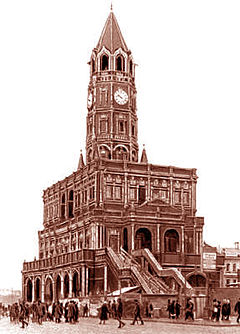Sukharev Tower
| Sukharev Tower | |
|---|---|
 |
|
| General information | |
| Architectural style | Naryshkin Baroque |
| Location | Moscow, Russia |
| Construction started | 1692 |
| Completed | 1701 |
| Demolished | 1934 |
| Design and construction | |
| Architect | Mikhail Ivanovich Choglokov |
The Sukharev Tower (Сухарева башня) was one of the best known landmarks and symbols of Moscow until its destruction by the Soviet authorities in 1934. The tower was built in the Moscow baroque style at the intersection of the Garden Ring with the Sretenka street in 1692-1695.
Tsar Peter the Great ordered the construction of the tower to commemorate his triumph over his sister Sofia. The tower was named in honor of L. P. Sukharev whose regiment of streltsy had supported Peter. The brick tower was built from 1692 through 1701 under the direction of the architect Mikhail Ivanovich Choglokov. It was not a fortress but rather a ceremonial gateway into the city.
The first floor formed an arched entrance/exit to the city. The second floor was guardrooms. Originally these were for barracks for Sukharev's regiment of streltsy but the streltsy were disbanded at the end of the 17th century. The third floor housed the Moscow School of Mathematics and Navigation. The school was part of Peter's grand plan to introduce western education to Russia. Some remodeling was done in 1701 by Choglokov. Count Yakov Bruce made the upper story his astronomical observatory, the first in Russia. The fourth floor had a clock and a state coat of arms. "An attractive typically Muscovite, wide exterior staircase led to a gallery on the first floor and surrounded the building."
Catherine the Great allowed Moscow merchants to use the tower premises for storehouses and shops.
Catherine the Great ordered a water supply system built from the village of Mytishchi to Moscow. The Mytishchi Water Conduit was built between 1779 and 1804 and ended near the Sukharev tower to dispense water. Between 1826 and 1835 engineer major general Nikolai Ivanovich Yanisch repaired and expanded the Mytishchi Water Supply. At this time two steam engine powered pumps and a cast iron tank holding 5000 (buckets) gallons of water were built on the second floor of the tower to improve the water pressure. Pipes from the tower lead to fountains. One of these fountains, called Sheremetev was located in the Sukharev square near the tower.
A large market, or Sukharevka, was bustling around the tower in the 19th century. In 1921 the Soviet government turned the tower into the Moscow Municipal Museum, which later became the Moscow City Museum. The Soviet government also closed down the famous flea market in 1925. It is said that Lenin felt that the market was a "breeding ground for speculation."
...
Wikipedia
